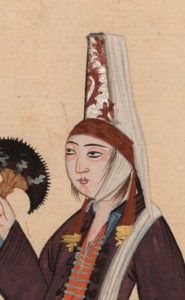The nezkeb–or nezkep, mezkep, or mezkeb, among dozens of other pronunciations–is something of a mystery. It’s a decorative and often highly valuable scarf worn as part of a woman’s headdress. Records from the imperial workshops suggest nezkebs were woven to half the width of standard cloth; marketplace price lists record nezkebs in a variety of expensive silks, including at least one silk that was apparently used only for nezkebs. Nezkebs continued to be worn regardless of hat style–pillbox, short cone, or sugarloaf–even though the three styles are so different that all the veils and ornaments surrounding them had to be altered.
So how were they worn?
One theory is that the original 16th-century nezkeb was the long fringed scarf some women wore hanging down their backs, under their hats. My research partner, Alison Petrisek, and I have found no other name for this scarf, and it’s a good location to display valuable textiles.

A fille de joie with an arakçin tied to her head with a veil (makrama) and a short, fringed red scarf (nezkeb?), circa 1625.
We don’t have enough information to speculate about how the nezkeb was worn with the conical hats fashionable at the turn on the century, but when the sugarloaf-shaped arakçin came into style, it was often worn with a brightly colored fringed scarf tied around the forehead. If this scarf isn’t a repurposing of the çember–which seems unlikely, since çember were generally plainer–then it may be the hot new way of wearing a nezkeb.



